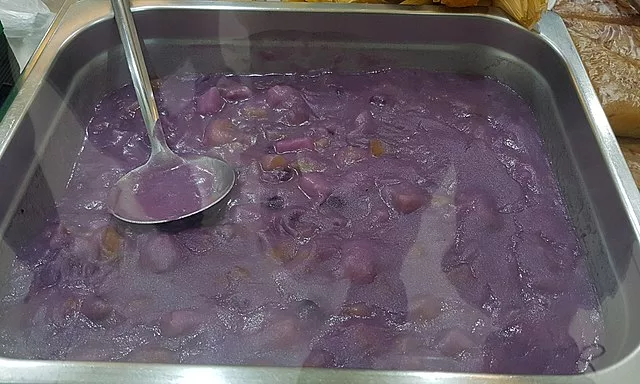
Binignit: A Sweet Symbol of Filipino Culture
A Warm Embrace of Flavors and Traditions
Binignit is more than just a dessert; it’s a warm embrace of flavors and traditions deeply woven into the fabric of Filipino culture. This delightful stew of root vegetables, fruits, and tapioca pearls simmered in rich coconut milk is a delightful treat enjoyed during the Lenten season, religious festivals, and family gatherings alike.
A Mosaic of Sweet and Savory
Imagine a vibrant mosaic of textures and flavors dancing on your tongue. The chewy bite of tapioca pearls mingles with the soft sweetness of taro and purple yam, while the contrasting textures of jackfruit and banana add a playful touch. Each spoonful is a revelation, a harmonious blend of sweet and savory notes, all brought together by the comforting embrace of creamy coconut milk.
A Journey Through Filipino Heritage
The name “Binignit” itself whispers of its rich heritage. Derived from the Cebuano word for “mixed,” it perfectly captures the essence of this dish. It’s a culinary tapestry woven from generations-old recipes, passed down through families and communities. Each variation, with its unique blend of ingredients and flavors, tells a story of regional identity and personal preferences.
Beyond Deliciousness: A Nutritional Powerhouse
But Binignit isn’t just a delightful indulgence; it’s also a nutritional powerhouse. The root vegetables are packed with fiber, vitamins, and minerals, making them a healthy and satisfying treat. Coconut milk, with its creamy texture and rich flavor, adds a touch of healthy fats and lauric acid, known for its numerous health benefits.
A Taste of Home, Wherever You Are
Binignit transcends borders and generations. It’s a taste of home, a warm reminder of loved ones and cherished traditions, no matter where life takes you. Whether you’re savoring it in the heart of the Philippines or miles away, each spoonful transports you back to a place of laughter, community, and shared joy.
So, the next time you encounter this vibrant Filipino treasure, remember that it’s more than just a dessert. It’s a celebration of culture, a testament to tradition, and a delicious symbol of the Filipino spirit.
Binignit: A Hearty Filipino Dessert
Binignit is a warm and comforting dessert soup from the Philippines, traditionally enjoyed during the cold months or special occasions. Made with a vibrant medley of tropical fruits, sweet potatoes, and tapioca pearls, it’s a delightful symphony of textures and flavors.
Here’s a simple recipe to whip up a pot of this beloved Pinoy treat:
Ingredients:
- 1 cup taro, diced
- 1 cup purple yam, diced
- 1 cup sweet potato, diced
- 1 cup ripe jackfruit, diced
- 1 cup ripe bananas, sliced
- 1 cup cooked sago pearls
- 1 (13.5 oz) can coconut milk
- 2 cups water
- 1/2 cup to 1 cup brown sugar, to taste
- Pandan leaves (optional)
Instructions:
- Bring the water to a boil: In a large pot, bring the water to a rolling boil.
- Simmer the root vegetables: Add the diced taro, purple yam, and sweet potato to the boiling water. Reduce heat to medium and simmer for 10-15 minutes, or until the vegetables are tender.
- Incorporate the fruits and sago: Add the jackfruit, bananas, and cooked sago pearls to the pot. Let them simmer for another 5 minutes.
- Enrich with coconut milk and sugar: Pour in the coconut milk and whisk in the brown sugar, starting with 1/2 cup and adjusting to your desired sweetness.
- Infuse with pandan aroma (optional): If using, tie a couple of pandan leaves into a knot and toss them into the pot. Let the binignit simmer for another 5-10 minutes, allowing the pandan’s delicate fragrance to infuse the soup.
- Cool and savor: Remove the pandan leaves (if used) and let the binignit cool down slightly. Serve warm or chilled, and enjoy the delightful mix of textures and flavors in every spoonful!
Tips:
- Feel free to adjust the amount of sugar to your liking.
- You can substitute canned jackfruit with fresh jackfruit, but be sure to cut it into bite-sized pieces and simmer it for a few minutes before adding it to the pot.
- Get creative! Binignit is a versatile dish that welcomes other ingredients like pumpkin, langka (jackfruit blossom), or even ube (purple yam). Experiment and find your perfect combination!
I hope this simplified recipe helps you prepare a delicious pot of binignit and experience a taste of Filipino warmth and comfort. Mabuhay!
Binignit Recipe Visayas Philippines
Introduction 🌈
In the vibrant tapestry of Filipino cuisine, Binignit emerges as a radiant star, casting its flavors across the Visayan region. Let’s embark on a delightful journey into the heart of Binignit, exploring its roots, savoring its diverse ingredients, and understanding its significance in Filipino culture.
History and Origin 📜
Unraveling the threads of history, Binignit takes us back to ancient times in the Visayan islands. Its origins are steeped in tradition, weaving a narrative that reflects the cultural tapestry of the Philippines. Binignit isn’t merely a dish; it’s a living testament to the rich heritage of the Filipino people.
Ingredients for Binignit 🍠🍌
At the core of Binignit lies a harmonious blend of ingredients that paint a colorful palate. From the earthy sweetness of sweet potatoes to the tropical notes of jackfruit and the comforting chewiness of glutinous rice balls, each component plays a crucial role in creating this symphony of flavors.
Preparation Process 🍲
Cooking Binignit is a culinary dance, a rhythmic process that transforms raw ingredients into a delightful masterpiece. Join us as we guide you through the intricate steps, from the careful peeling of tubers to achieving the perfect consistency of coconut milk, ensuring your Binignit is a culinary triumph.
Flavors and Aromas 👃🍯
Close your eyes, take a bite, and let the flavors of Binignit transport you. The sweet potatoes add a subtle sweetness, the jackfruit introduces a tropical twist, and the coconut milk infuses a rich creaminess. Engage your senses as we delve into the enchanting aromas and tastes that make Binignit a sensory experience.
Binignit and Festivals 🎉
Picture a festival in the Visayan region, and you’ll likely find Binignit at its heart. Whether it’s the vibrant Sinulog or the colorful Pintados-Kasadyaan, Binignit takes center stage, symbolizing the abundance of harvest and the joy of communal feasting.
Health Benefits 🌱💪
Beyond its deliciousness, Binignit offers a healthful boost. Packed with essential vitamins, minerals, and fiber from its natural ingredients, Binignit becomes more than a dessert—it’s a nutritious contribution to a well-balanced diet.
Variations Across Visayas 🗺️
As you traverse the Visayan islands, you’ll encounter unique variations of Binignit. Each region puts its spin on the classic recipe, incorporating local fruits and introducing subtle differences that showcase the diversity of Filipino culinary traditions.
Binignit in Modern Cuisine 🌐👩🍳
In the ever-evolving world of culinary arts, Binignit has found its way into modern kitchens. Chefs worldwide experiment with contemporary adaptations, infusing Binignit flavors into ice creams, cakes, and other innovative desserts, showcasing the dish’s adaptability and universal appeal.
Culinary Traditions and Stories 📖👨👩👧👦
Binignit isn’t just a recipe; it’s a repository of stories and traditions. Families pass down their Binignit recipes, creating a connection between generations and preserving cultural heritage through the joy of cooking.
Popular Accompaniments 🍵🍰
Pairing Binignit with other Filipino delicacies elevates the dining experience. Whether it’s the classic bibingka or a contemporary dessert, these pairings complement and enhance the flavors of Binignit, creating a symphony of tastes on the palate.
Binignit: More Than a Dessert 🌟🍧
Beyond its status as a dessert, Binignit holds cultural significance. It serves as a centerpiece in social gatherings, fostering connections and creating lasting memories among family and friends. Binignit becomes a symbol of unity, bridging generations and celebrating the shared joy of good food.
Tips for Perfect Binignit 🌺👩🍳
Embarking on your Binignit journey? Learn from the experts as they share valuable tips, ensuring your Binignit is a delightful culinary masterpiece. From ingredient selection to cooking techniques, these insights will guide you towards achieving perfection in every bowl.
Binignit: A Family Tradition 👨👩👧👦❤️
In Filipino households, Binignit isn’t just a dish; it’s a family tradition. Explore the emotional connection people have with Binignit, as they cherish the memories of preparing and sharing this beloved dessert. Discover how Binignit becomes a vessel for family stories, uniting generations in the kitchen.
Conclusion 🌟🎊
In the mosaic of Filipino cuisine, Binignit stands as a vibrant masterpiece. As we conclude our journey through the history, flavors, and cultural significance of Binignit, we invite you to explore and savor this delightful dish. Let the spirit of Visayan culinary artistry inspire your next culinary adventure.
Frequently Asked Questions (FAQs)
Can I use canned coconut milk for Binignit?
While fresh coconut milk is preferred for an authentic flavor, canned coconut milk can be a convenient alternative.
Are there vegetarian variations of Binignit?
Absolutely! You can omit meat ingredients and focus on the array of fruits and tubers for a delicious vegetarian version.
Can I prepare Binignit in advance for a party?
Yes, Binignit can be prepared in advance. However, it’s best enjoyed fresh for optimal taste and texture.
What is the significance of Binignit during Lent?
Binignit is often associated with Lent as it traditionally avoids using meat, aligning with the Lenten tradition of abstinence.
Can I taste the authentic Binignit outside the Philippines?
While the authentic experience is best enjoyed in the Philippines, some Filipino restaurants worldwide may offer a taste of traditional Binignit.
You may also like
- https://bestphilippinestravelguide.com/filipino-food/
- https://bestphilippinestravelguide.com/siquijor-delicacies/
- https://bestphilippinestravelguide.com/jollibee-menu/
- https://bestphilippinestravelguide.com/food-festivals-in-the-philippines/
- https://bestphilippinestravelguide.com/weird-filipino-food/
